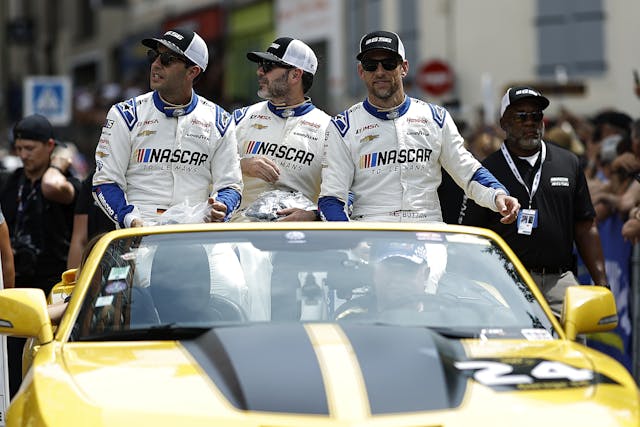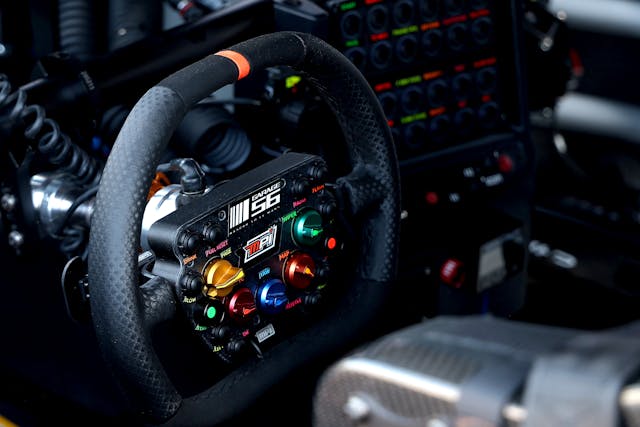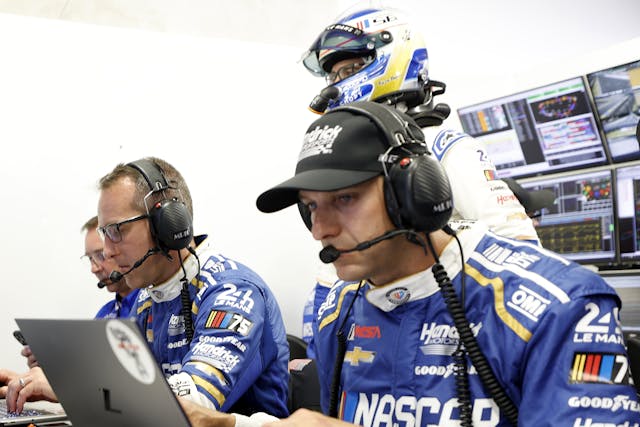Crew chief for Garage 56 Camaro is working his “dream job”
Whenever being a crew chief starts to feel like work, Greg Ives thinks back to March 22, 2004. That day, he started working for Hendrick Motorsports, the stock-car racing team owned by mega car dealer Rick Hendrick and based in Charlotte, North Carolina. Working for Mr. Hendrick, as Rick is called by everyone who works for him, was Ives’ dream job.
Ives, 43, has been a winning NASCAR Cup crew chief for Hendrick drivers like Dale Earnhardt, Jr. and Alex Bowman. Last year, he stepped down from the 39-week-a-year grind of being Bowman’s full-time crew chief to spend more time with his family. His son is climbing the ranks of karting, “my daughter is graduating next year, and the middle one is playing softball,” Ives said. “I can’t miss any more of that.”
Fortunately, the perfect job was waiting: Build and crew-chief the 24 Hours of Le Mans Garage 56 entry, a specially equipped NASCAR Chevrolet Camaro ZL1.

A collaboration between NASCAR, Chevrolet, Goodyear, and Hendrick Motorsports, the Garage 56 Camaro was the brainchild of NASCAR chairman and CEO Jim France. France is also the chairman of IMSA, the NASCAR-owned sports-car racing series that sanctions the IMSA WeatherTech SportsCar Championship’s Rolex 24 Hours at Daytona. With IMSA’s top GTP Prototype class now legal for competition in this year’s 24 Hours of Le Mans, France wanted to take the connection one step further.
“I would have never come up with this idea if [NASCAR chairman] Jim France hadn’t tapped me on the shoulder,” said Rick Hendrick. “Once you get involved in something like that, it gets very exciting. To me, I want to showcase our very best. I want people to look at this car and say, ‘Wow, they did something remarkable here.'”

Garage 56 originated in 2012 as a one-car, exhibition-only class for vehicles that showcased unorthodox technology and didn’t fit in any of the classes established by the ACO, the race’s sanctioning body. Because each Le Mans entry has a garage, and there had long been 55 of them, the entry was dubbed Garage 56. The first was the oddball but successful DeltaWing, styled by Chip Ganassi Racing designer Ben Bowlby and built by Dan Gurney’s All American Racers company.
The DeltaWing was an ultra-lightweight, ultra-streamlined car that used a four-cylinder engine to run lap times comparable to those of V-8-powered, scratch-built prototypes. After the DeltaWing did its exhibition run at Le Mans in 2012, the American Le Mans Series accepted the car as a full-fledged competition entry. It probably helped that the founder of ALMS was also the DeltaWing’s owner: Dr. Donald Panoz, the wealthy inventor of the nicotine patch.
2023’s Garage 56 Camaro began life as a NASCAR stocker. To run a 24-hour endurance race, it gained functioning headlights and taillights, a larger fuel cell, carbon-ceramic brake discs, and specially designed Goodyear Eagle race tires. Drivers were seven-time NASCAR Cup champ Jimmie Johnson, former Formula 1 champion Jensen Button, and two-time Le Mans winner Mike Rockenfeller, who did the lion’s share of pre-race testing.

“From the beginning of this project, it was important to us that the car we bring to Le Mans is a true NASCAR stock car,” said France, the NASCAR chairman. “While there have been some adjustments to allow the car to compete in a 24-hour endurance race, fans in Le Mans would be treated to the full NASCAR experience.”
Boy, were they.
“We thought we were going to have a little bit of resistance to NASCAR, to our American style coming into Le Mans. We figured the reaction would be mixed—some would love it, some would hate it. But oh my gosh! Nothing further from the truth,” Ives said. “Everybody loved it. The fans loved it, and the crew members—we had crew members coming down from other teams asking for a quick tour. The reception was pretty awesome even before they knew how it sounded on track… how it performed.”

The rules for a Garage 56 exhibition car are relatively open. Ives had two goals: To keep the Camaro looking like a NASCAR stocker, and to run with the GT cars. (Each of those GT entries starts life as a real car, as opposed to the cars in the ground-up Prototype class, which Ferrari won.) There were plenty of GT Ferraris, Aston Martins, Porsches, and even Corvettes going for the GT win. Ives did not want his car to get in the way on the 8-mile track.
So was the Camaro more Cup car, or more GT3 car? “In terms of looks, it was more of a Cup car, but with all the aero bits that the GT cars allow to create some downforce. We kind of lack the ability to put downforce in a Cup car efficiently, so we added front dive planes and the rocker wedges and the rear canards, and you’re able to do that and get downforce in the car efficiently. When we were able to do that it just gave the car a lot of its overall speed. It allows you to have the straight-line speed, but also the cornering speed that you needed to compete.

“We worked on a scale that was respectable and also put ourselves in a situation with the other cars so they knew that we’d be predictable and they’d be able to get around us. Looks-wise, it was definitely a Cup car, but from an aero-efficiency standpoint, we were more along the lines of a GT car. Obviously, a big wing versus a spoiler on the rear is probably the next step we probably could have taken, but we didn’t want to take away from the look of the Cup car in itself.
“The driveshaft, transaxle, the suspension, most everything was Cup-based. The motor was more along the lines of the 5.5-liter IMSA motor due to the fact that they had experience with being able to go 24 hours. It’s still a Cup-based block and heads, I believe, just a little bit different build to have some more endurance in it. Instead of being built to run 400 to 600 miles two or three times, this engine was meant to run 3000 miles one time.”

The ACO, the sanctioning body for Le Mans, was afraid the 3000-pound Camaro would be very slow in the track’s Porsche curves, slow enough to stack up traffic behind it. So they planned to wave a white flag at the entrance of the curves, the signal for “slow car ahead.”
“That flag disappeared after a couple of laps,” Ives said, laughing. “They knew they didn’t need it.”
The usual small problems, such as brakes and sensors, were factors, but it wasn’t until about four hours were left in the race that the lone major problem reared its head—a transmission failure. True, the Garage 56 racer wasn’t technically racing, but tell that to Ives, Button, Johnson, and Rockenfeller. The team took their time making sure the car was perfect before sending it back out. They lost more than an hour, dropping the Camaro overall from about 28th to 39th, where it finished out of 62 cars.

It annoyed Ives that some of the media reported that the Camaro “limped around” for the final few hours. That wasn’t true: “We put Rocky in the car, and he went out and turned the fastest lap we’d done all race.”
And how fast was that? The winning Corvette was the fastest GT car, notching a best lap of 3 minutes, 50.439 seconds. The Camaro’s fastest lap was an incredible 3:50.512, faster than every other GT car, including those Ferraris, Porsches, and Aston Martins. In the end, the Garage 56 Camaro covered 285 laps, beating 12 of the GT cars.
As for Ives: “He was amazing,” said John Doonan, president of IMSA, former head of Mazda Racing and the project chief for Garage 56. “I told him after the race that his work on the radio was tremendous… Methodical, just like an endurance racing veteran!”

So what’s next? The Garage 56 car (there are two race cars and a show car) went to Brands Hatch in England for a major car show and will go to Goodwood to run the July hill climb. Afterwards, it’s likely Hendrick and France will each get one of the race cars, and the show car will go on tour in the United States.
As for Ives, he’ll be crew-chiefing some Xfinity races this year. Last weekend, however, he was in Indiana, where his son was competing in the U.S. Pro Kart Series at New Castle Motorsports Park.
Would Ives like to go back to Le Mans? “I’d love to, especially if we could do it with all the same people. But like always, I’ll work wherever Mr. Hendrick needs me. If he puts me to sweeping floors, I’ll be the best floor sweeper out there!”

***
Check out the Hagerty Media homepage so you don’t miss a single story, or better yet, bookmark it. To get our best stories delivered right to your inbox, subscribe to our newsletters.



It was fun to see this car go out and race and post some respectable times. Would be nice to see more road course stuff with this car.
It would be fun to see a behind the scenes and on the track documentary of this year’s effort. Maybe next year?
I remember Dan Gurney took a 409 powered Chevy overseas and held his own against the European cars. Can’t remember the exact place or cars he competed against. Maybe someone else remembers more.
https://www.motortrend.com/features/1706-dan-gurney-goes-jaguar-hunting-in-1961-with-this-hot-409-powered-chevrolet-impala-ss/
Thanks.
Would love you folks to do a follow up report from Greg as to what changes were made to the 1 time 3000 mile engine from the 3X 4-600 mile engine.
We watched from Arnage. It was a hoot every time the Camaro came around. It sounded so much different than every other car there. Well done.